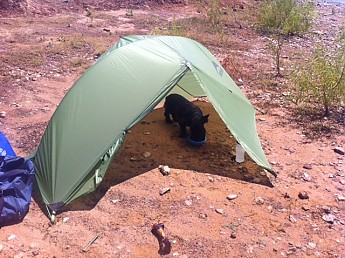The Follies of Fast-Pitching with a Footprint
Although manufacturers tout their tents' fast-pitch weight (using an optional footprint with poles and a rain fly) we don't believe this type of shelter is viable for backpacking in wind or rain. Compared to floorless tents, fast-pitching has two significant limitations: (1) it's much weaker, and (2) it's much less weather resistant. Most double-wall tents have a specific inner tent that supports the pole structure and has a 4-8" waterproof walls that protects against splashback and horizontally blown rain. Footprints are cut to match the inner tent's floor dimensions, so if fast-pitching a tent in the rain, we've found that water almost always lands on the footprint, creeps inward, and gets us wet. Grommets in the footprint provide the support for the poles, so you can't fast-pitch without a footprint or roll the footprint back from the dripping rain. Furthermore, since most outer tents attach to the poles from the outside with velcro, fast pitching is inherently weak, and made weaker by the fact that many outer tents have no means to connect to the poles— they may only clip the footprint—and, therefore, guying the outer tent out is completely useless. For these reasons we don't believe that fast-pitching a tent is viable for serious backpacking. It's largely just a marketing gimmick.
However, the Hilleberg Anjan and MSR Hubba Hubba NX are dedicated pole-supported tents in our review finalists that can be used without their inner tents in significant rain or wind and can be pitched in a floor-less configuration. We like this floor-less configuration because it is stronger than the typical "fast-pitch" and does not require purchasing a separate footprint.





 Ответить с цитированием
Ответить с цитированием